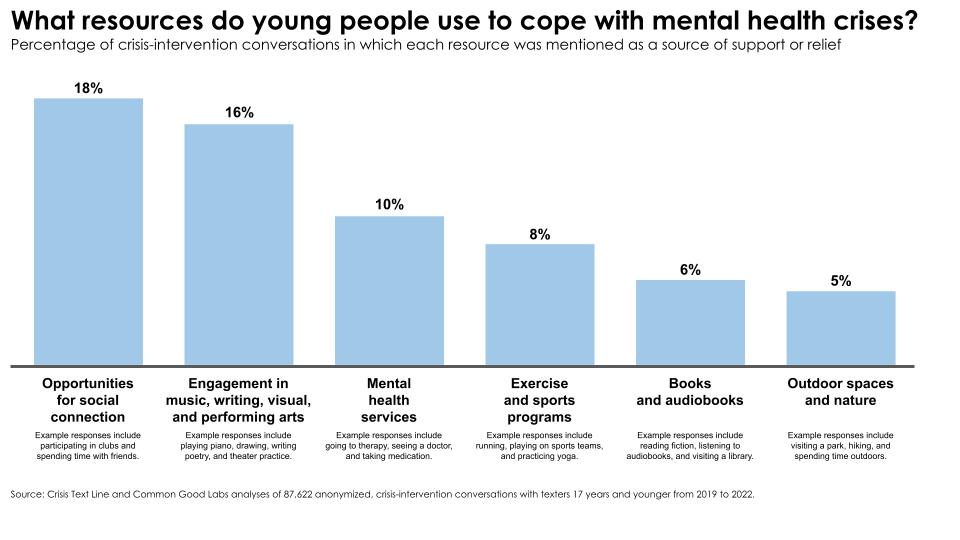What Do Young People in Crisis Need From Their Communities?
A new report from Crisis Text Line and Common Good Labs offers solutions to the youth mental health crisis based on over 87,000 anonymized conversations with young people who talked about what helps them cope.
Young people are facing a mental health epidemic.
Young people across the United States are sad and hopeless. Over 1 in 6 high school students have made a suicide plan; over 40% of them are sad. Over five million adolescents experienced depression in 2022, up from two million in 2010. More than 1,500 died by suicide in the same year, compared to less than 1,000 in 2010.
Though depression and suicides fell in 2022, both are still far above the levels seen twelve years earlier. Suicides have grown in communities across every geographic region in the United States. These increases can be seen in more rural states, such as Alabama and Idaho, as well as those that are primarily urban, like California and New York.
Communities need solutions to protect youth mental health.
We partnered with Common Good Labs to find solutions to this crisis – and learn what young people say they need from their communities. We analyzed over 87,000 anonymized conversations with young people where they mentioned coping resources that help them feel better in a crisis. We used Natural Language Processing (NLP) to identify these resources; we then paired these insights with public data on their availability over time and across ZIP codes and counties. (We defined young people as 17 or younger.)
The full report called, “What Do Young People in Crisis Need from Their Communities? Solutions to the epidemic of depression and suicide among adolescents in the United States”, is available to download below.
Research Highlights
Adolescents say there are six resources communities can provide to help them cope with mental health crises.
It’s not just therapy – it’s opportunities for social connection, it’s art classes, sports, libraries, and walkable neighborhoods. Many of these may not be obvious, but young texters regularly turn to them to cope with crises – and they all require community investment. They are:
- Opportunities for social connection;
- Engagement in music, writing, visual, and performing arts;
- Mental health services;
- Exercise and sports programming;
- Books and audiobooks; and
- Outdoor spaces and nature, including walkable neighborhoods
Unfortunately, communities have been cutting programs that provide the resources youth in crisis need.
Based on our analysis of public data sources, local governments cut funding for parks by more than $2.5 billion dollars from 2010 to 2021. Opportunities for social connection and playing sports also shrank considerably during this time — even though the youth population increased. The number of children participating in clubs fell by 1.4 million and the number playing high school sports dropped by 1.8 million. The availability of arts education decreased as well.
Today, many young people lack access to community resources that would support their mental health.
When young people struggle with mental health distress, large numbers of them do not have access to coping resources.
As a result of the cuts and declines in participation,
- Seven in ten children do not participate in clubs.
- Five in ten adolescents with depression do not receive treatment.
- Five in ten high schoolers do not play sports.
- Four in ten children do not live near a library.
Many of these resources are even more limited in rural counties and underserved ZIP codes within cities.
Communities should reframe their approach to mental health support.
Our findings suggest that leaders would benefit from reframing the way they think about mental health support for youth. Extracurricular clubs, arts education, sports activities, libraries, and outdoor spaces are important services and programs for supporting young people’s mental health — in addition to the intrinsic value that each brings to local communities.
With questions on methodology, please email research@crisistextline.org.
With press requests, please email press@crisistextline.org

